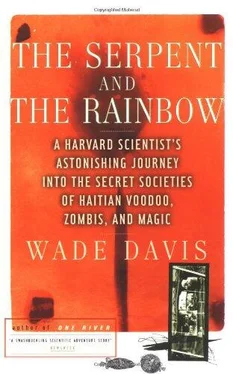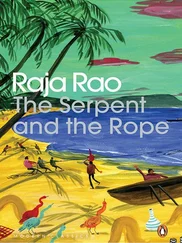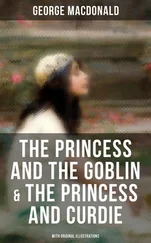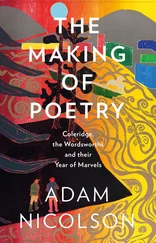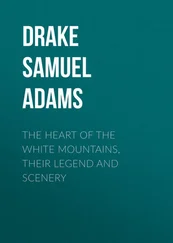Wade Davis - The Serpent and the Rainbow
Здесь есть возможность читать онлайн «Wade Davis - The Serpent and the Rainbow» весь текст электронной книги совершенно бесплатно (целиком полную версию без сокращений). В некоторых случаях можно слушать аудио, скачать через торрент в формате fb2 и присутствует краткое содержание. Год выпуска: 1985, Издательство: Simon & Schuster, Жанр: Старинная литература, на английском языке. Описание произведения, (предисловие) а так же отзывы посетителей доступны на портале библиотеки ЛибКат.
- Название:The Serpent and the Rainbow
- Автор:
- Издательство:Simon & Schuster
- Жанр:
- Год:1985
- ISBN:нет данных
- Рейтинг книги:5 / 5. Голосов: 1
-
Избранное:Добавить в избранное
- Отзывы:
-
Ваша оценка:
- 100
- 1
- 2
- 3
- 4
- 5
The Serpent and the Rainbow: краткое содержание, описание и аннотация
Предлагаем к чтению аннотацию, описание, краткое содержание или предисловие (зависит от того, что написал сам автор книги «The Serpent and the Rainbow»). Если вы не нашли необходимую информацию о книге — напишите в комментариях, мы постараемся отыскать её.
The Serpent and the Rainbow — читать онлайн бесплатно полную книгу (весь текст) целиком
Ниже представлен текст книги, разбитый по страницам. Система сохранения места последней прочитанной страницы, позволяет с удобством читать онлайн бесплатно книгу «The Serpent and the Rainbow», без необходимости каждый раз заново искать на чём Вы остановились. Поставьте закладку, и сможете в любой момент перейти на страницу, на которой закончили чтение.
Интервал:
Закладка:
PART TWO
Interlude at Harvard
7
Columns on a Blackboard
ON EASTER SUNDAY I passed through United States Immigration at Kennedy Airport in New York carrying a kaleidoscopic Haitian suitcase constructed from surplus soft drink cans. The specimens inside included lizards, a polychaete worm, two marine fish, and several tarantulas—all preserved in alcohol—as well as several bags of dried plant material. Two rum bottles contained the antidote, while the poison itself was in a glass jar wrapped in red satin cloth. There was also a dried toad, several seed necklaces, a dozen unidentified powders, and two vodoun wangas , or protective charms. Two human tibia and a skull were at the bottom of the case. A cardboard box was full of herbarium specimens, and concealed inside in a duffle was a live specimen of the bouga toad. The customs agent opened the cardboard box, took a quick look, and told me he didn’t even want to hear about it. He never saw the toad.
There was no one in when I rang Nathan Kline from the airport, so I left word on his answering machine and caught the next plane for Boston, arriving in Cambridge slightly after dusk. I found the Botanical Museum deserted. I was tired, and when I entered my office I placed the tin suitcase on my desk and, without turning on the lights, lay back in a hammock I had strung across a corner. It was amusing to look at that colorful case so symbolic of an entire nation. Haiti, it is said, is the place to discover how much can be done with little. Tires are turned into shoes, tin cans into trombones, mud and thatch into lovely, elegant cottages. Material goods being so scarce, the Haitian adorns his world with imagination. Yet if there was anything silly about the suitcase, there certainly was not about its rank contents. If the mystery of the zombi phenomenon was to be solved, these specimens were the most important clues. Without them, there was nothing concrete. With them, I could take full advantage of the resources of the university.
I stood up and emptied the case, placing the specimens in a long row across the back of my desk. Then I took a piece of chalk and drew a column at either end of a large blackboard that covered much of one wall. On the left I listed the ingredients in Marcel’s poison: human remains, the two plants, the sea worm, toad, lizards, and fish. On the right I wrote the medical symptoms of Clairvius Narcisse at the time of his death: pulmonary edema, digestive troubles with vomiting, pronounced respiratory difficulties, uremia, hypothermia, rapid loss of weight, and hypertension. After a moment’s recollection, I added cyanosis and paresthesia, for both Narcisse and his sister had mentioned that his skin had turned blue, and that he felt tingling sensations all over his body. In between the two lists was a very large blank space.
Early the next morning I passed through the dark corridors of the Museum of Comparative Zoology and deposited the animal specimens with the museum’s various specialists for identification. Then I returned to the Botanical Museum to have a look at the plants. I had three initial questions. Did the plants have pharmacologically active compounds that might cause a dramatic decrease in metabolic rate? If so, were the strength and concentration of the compounds sufficient to be effective in the doses used by Marcel Pierre? And finally, were they topically active, or did they have to be ingested? All three were tempered by an important consideration. Very often in folk preparations, different chemicals in relatively small concentrations effectively potentiate each other, producing a powerful synergistic effect—a biochemical version of the whole being greater than the sum of the parts. Thus my primary concern was to demonstrate whether or not any of the plant or animal ingredients contained interesting chemical compounds. Once the specimens were identified, I would find most of this preliminary information in the library.
Late that afternoon the museum secretary interrupted me with a message from Kline asking me to return as soon as possible to New York.
The door to the apartment was open. I went in, stood rather tentatively for a moment in the alcove, then wandered into the living room. The decor was unchanged, but the late afternoon sun left the air hot and compressed and tinged every object with color.
“You seem to be all right.” I turned around, and Kline’s daughter Marna was behind me, smiling and leaning against the doorway to the kitchen. “Welcome back.”
“Hello, Marna. Sorry if I’m barging in.”
“It’s fine. Father told me you’d be coming. How was Haiti?”
“It’s a good place.”
“And the work?”
“Okay.”
“Was he right?”
“Your father?”
She nodded. “No, don’t tell me, don’t say anything. Wait until he gets here. Can I pour you a drink?”
“That’d be nice.”
“Some rum, or have you had it?”
“I’ll take a whiskey.”
Marna went back into the kitchen to get some ice and then walked over to the bar. “He was worried, you know.”
“Your father? Why?”
“Weren’t you a week late getting back?”
“I don’t think so.”
“He expected you several days ago.”
“There were a few delays,” I said. “Where’s your father now?”
“Oh, I’m sorry. He just stepped out. He should be right back. Bo Holmstedt is with him. Do you know him?”
“He is? Yes I do.” This was a surprise. Bo Holmstedt is a professor at the Karolinska Institute in Stockholm and one of the world’s foremost toxicologists. He and Schultes were good friends and had collaborated on a number of projects in the Amazon.
Marna and I were having a second drink when her father and Holmstedt returned. Nathan Kline seemed a different man from our first meeting—warm, even affectionate as he greeted me.
“There you are. All in one piece, I’m glad to see. You know Bo Holmstedt?”
“Professor.”
“Hello, Wade.”
“Bo was on his way to the airport, but I’ve persuaded him to wait until he hears what you’ve got to tell us.”
“Now, Nathan, don’t put the lad on the spot,” Holmstedt said. “Marna, haven’t you got a quick drink for an old sot?” He spoke with the accent of a Scandinavian educated in Britain. An elderly man, short and heavyset, he was dressed conservatively in gray flannels and a blazer. We chatted informally until all were comfortably settled, and then I began my account. In a necessarily anecdotal way, and responding to frequent questions, I shared my instincts for the country, its history and unique social structure, stressing repeatedly the importance of the vodoun religion as the axis around which so much of Haitian life revolves. Then I recounted the events that led up to my obtaining the preparation from Marcel Pierre. Finally, the conversation turned to the poison itself.
“I haven’t got all the determinations yet on the animals, but I have identified the plants. One is a liana known to the Haitians as pois gratter, the ‘itching pea.’ It’s Mucuna pruriens , and like just about everything else in the genus the fruits are covered with vicious urticating hairs.”
“Anything on its chemistry?” Kline asked.
“Not much. I spoke with Professor Schultes, and he seems to think the seeds are psychoactive. He’s also seen it used medicinally in Colombia to treat cholera and internal parasites.”
Holmstedt joined in. “There is a species of Mucuna called … Damn it, what is it? Yes, flagellipes . It’s used in central Africa as an arrow poison. Has something in it not unlike physostigmine. You know, of course, the literature on the Calabar bean?”
Читать дальшеИнтервал:
Закладка:
Похожие книги на «The Serpent and the Rainbow»
Представляем Вашему вниманию похожие книги на «The Serpent and the Rainbow» списком для выбора. Мы отобрали схожую по названию и смыслу литературу в надежде предоставить читателям больше вариантов отыскать новые, интересные, ещё непрочитанные произведения.
Обсуждение, отзывы о книге «The Serpent and the Rainbow» и просто собственные мнения читателей. Оставьте ваши комментарии, напишите, что Вы думаете о произведении, его смысле или главных героях. Укажите что конкретно понравилось, а что нет, и почему Вы так считаете.
